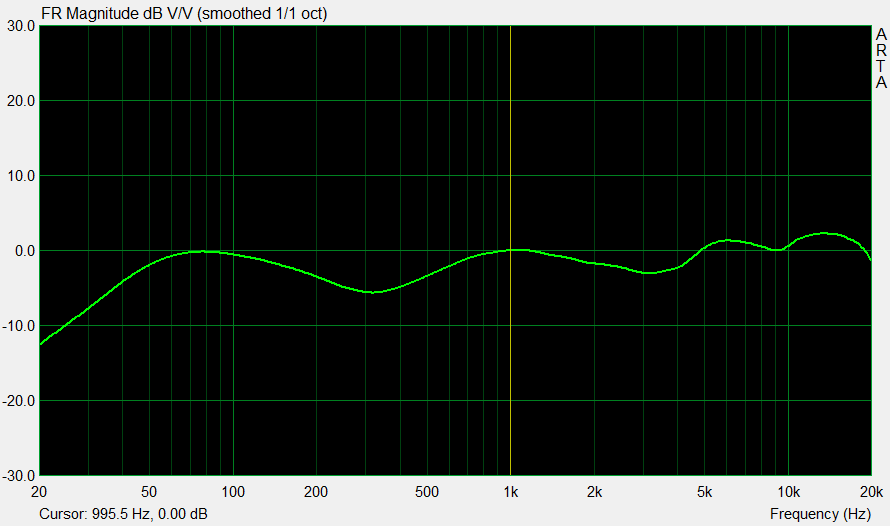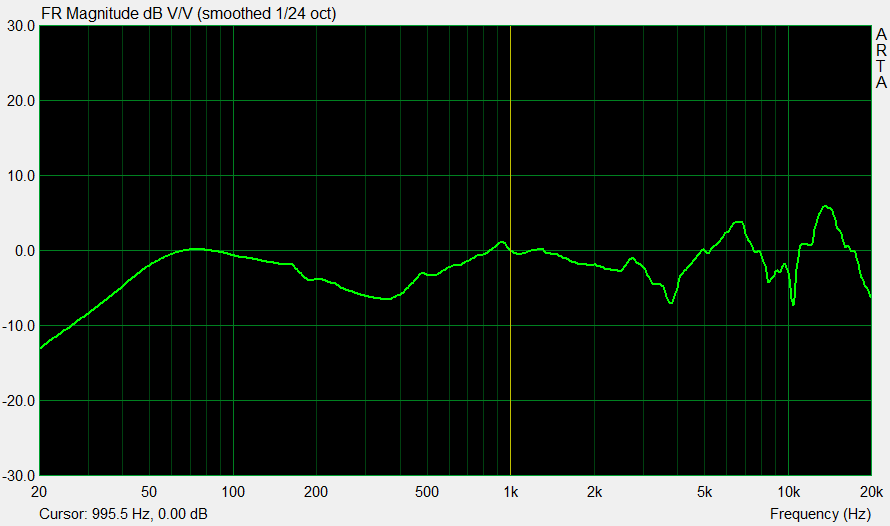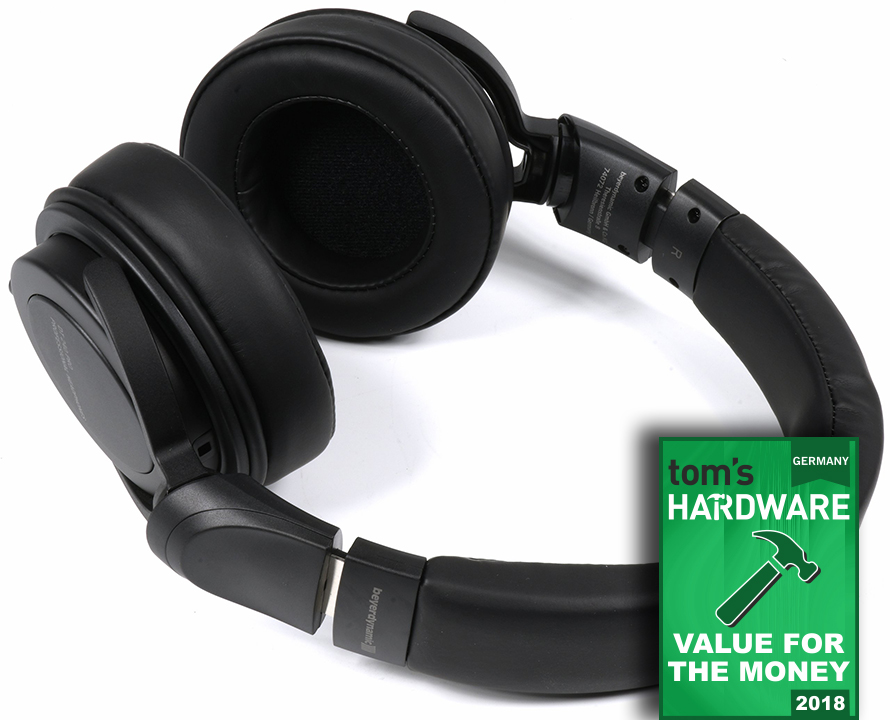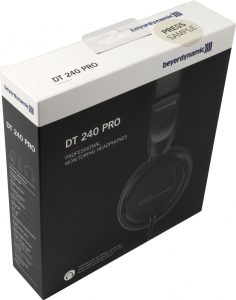Measurement of the frequency curve
Standardized to the value at 1 KHz and first, as usual with the PR films, also smoothed to an octave, the curve looks surprisingly neutral. Instead of the usual V, i.e. the media market-compatible mainstream bath satim with raised basses and heights, we find rather a kind of discreetly hinted W. With which the bass at approx. 65 Hz at the same level and the heights at approx. six or experience a slight increase at 14 KHz.

The smaller valley at approx. 380 Hz and the two dents at approx. 3.8 or 10.5 KHz can only be seen more clearly if you remove the smoothing almost completely, as on the next measuring curve:

But that looks more dramatic than it sounds. What one might suspect, however, would be a slight overemphasis on the hissands and in super high tone. But both types of games are not really new and In the subjective hearing test I will write something about it.
Cumulative Spectral Decay (CSD)
The curves of the spectral decay analysis provide further very useful information about the performance of the installed drivers. This analysis is based on the frequency response diagram shown above, but also contains the element Time and now shows as a 3D graphic ("waterfall") very clearly how the frequency response develops over time after the input signal has been stopped. In colloquial terms, such a thing is also called "end" or "swingout".
Normally, the driver should also stop as fast as possible after the input signal has been dropped. However, some frequencies (or even entire frequency ranges) will always subside slowly and then continue to appear in this chart as longer-lasting frequencies on the timeline. This is a good way to see where the driver might be particularly "squeaming" or where resonances may even occur and disturb the overall picture.

It is interesting that one finds hardly audible and measurable resonances. For an 85-euro headphones, this is almost a unique selling point and, let's face it, the small 900 Hz horn is even less than some headsets already have on average. By the way, the DT 240 Pro copes well with impulses, even if it doesn't look as pointed as neighbor's Lumpi after every single punch. But this is hardly feasible for the price.
So we can consider settling behavior and pulse fidelity to be done appropriately, the level strength by the way. The sensitivity is not over now and on some devices it will be difficult to achieve the full control, but it is actually not something that you would have to hang on to the apple phone or the pocket Androids. Even if it is possible by adapter or jack at any time. On the Beyerdynamic A20 and also the external SoundblasterX G6 you can easily get to the pain limit of your own spoons.
Subjective listening experience
Let's also test subjectively what you have in the original on your ear. I had the DT 240 hanging on the sound loop for a long time, which should take the wind out of the sails even the most hardened one-game fanatics, because approx. 80 operating hours should really be enough.
Bass
Test the lowest bass in the subcontraoctave (16.4 Hz to 32.7 Hz) with a recording of Bach's Toccata and Fugue in D minor (19 and 25 Hz) and the Festival Overture 1812 by Tchaikovsky (10 Hz and 12.5 Hz). The same applies to the lower ranges of the contraoctothe (32.7 to 65.4 Hz). The big bass drum (kick drum), which in the U-music is a welcome companion and usually on approx. 55 to 60 Hz, this assessment will then be rounded off.
The bass is clean, still surprisingly deep and quite lively, but without even appearing over-present. It is full, but not disproportionate. The subcontraoctave is audibly completely present and above all rather cleanly contoured, which surprises me even more personally. The minimal loss in the foundation should be due to cushions and contact pressure, if you are not standing on lemon presses and have bent the handle as described something.
But in this price range the bass is almost unique and I wouldn't know anything right away that you couldn't listen to it. The punch is also good, which the fun guerrilla is certainly good for.
The upper bass up to 150 Hz, in which also the Great Octave (65.4 to 130.8 Hz) is located, houses the basic language frequency of the male voice and decides very strongly on the true-to-life reproduction of male vocals.
This area sounds natural and warm, which is very much in line with the voice of male voices. It sounds full, warm and pretty much complete. Not only can you live well with this, but it also sets real standards under EUR 100. This very rich reproduction is quite conducive to gaming, because even very complex battlegrounds stand here on a granite-made foundation and it doesn't sizzle and distort anything at maximum bomb dropping rate.
Frequency range
The lower middles (also basic tone range) are approx. 150 to 400 Hz. Together with the already mentioned upper bass, this area plays a very important role for the subjectively perceived heat or bass. Fullness of the sound. The basic language frequency of female voices can be found in this area.
Female vocals seem a little weaker, and some instruments lose some of their fullness. But of course this is already meckering at quite a high level, because otherwise the sound will definitely come along. But complete perfection is not possible in this price structure, that has to be taken into account. The heat in this area goes back a bit into the neutral, but this never really slips into the cool. They are nuances, nothing more. The gamer can't care anyway, because the premise lies somewhere else.
The upper mids between 400 Hz and about two KHz contain a mark at a KHz, which is still considered a reference for many measurements. Unfortunately, this is often noticeable with cheaper devices, as manufacturers often try to overemphasize this frequency. This area does not play an insignificant role in gaming either, and balanced playback contributes significantly to good spatial resolution.
If the ride was just a little more subdued, the DT 240 Pro now puts a decent skip on it. This vote is not detrimental, especially for monitoring, because you actually hear everything here that might not have been heard. This is precise in every respect, even if it can't quite reach the water for good studio headphones. But the approaches are really good and you have to always keep the price in mind.
Just below a KHz, you can also notice a slight resonance with a lot of effort, which is more likely to come from the chassis. Funnily enough, this impression was gone when you put a thin foam layer in the shell. The fact that I don't recommend this as a mod is also due to the fact that it has other disadvantages and counteracts the otherwise impeccable tuning somewhat. Then rather the little gag.
High-pitched range
Between two and about 3.5 KHz, human hearing is most sensitive, especially since this area of the lower heights is responsible for the good overtone reproduction of the human voice. This frequency range is crucial for the recognition of a voice or instrument; in this context, one also speaks of the respective timbre.
The small peak at approx. 3.8 KHz brings a lot forward, which is safely submerged in the mass on some other headphones. But it also makes the DT 240 Pro seem louder than it actually plays. You have to like it, but it doesn't really bother you. In gaming, on the other hand, it is even advantageous, because even the quietest noise becomes easily perceptible and localizable if it is only broadband enough and also covers this area.
The middle heights (3.5 to six KHz) decide on the sound or failure of the speech reproduction as a whole, because the S- and hissing (Sibilants) fall into this range. The upper heights then reach up to approx. ten KHz to move into the super high tone.
The hissing squids are a little too dominant for my taste, whereby it scrapes past the metallic. It is just below what might best be called "sharp" and "crispy." Many people really like this interpretation and in the end you will have thought something of it with the manufacturer. That the super high tone at approx. 14 KHz again turned up, gifted. That's for the gallery anyway.
Resolution and spatial mapping
As with the Amiron, I find it very pleasant that the stage was not artificially spread on Devil's Come out. One sits almost with some distance from the event, whereby the spatial assignment of many simultaneously operating sources in this price class is above average. The depth graduation is good and the width is always sufficient. On the contrary, because who, for example, as a player sitting in front of the monitor, he actually hears everything exactly where he sees it (hopefully).
Listening to music on the DT 240 Pro is not a punishment, but actually a pleasure. In fact, one does not sit in the middle of the orchestra, but something in front of it, which is good and also helps to maintain the true-to-original character when recording and mixing. So from that point of view, everything has been done right. The real weaknesses of the DT 240 Pro are definitely not acoustic.

Summary and conclusion
 The DT 240 Pro is a very good all-rounder that cuts an equally good figure in gaming, monitoring and everyday music consumption. For professional use, the part is quite suitable, especially as a portable, if the demands and the price are in line. But there is still some air up, because you can get the cheapest DT 770 Pro for 30 euros more.
The DT 240 Pro is a very good all-rounder that cuts an equally good figure in gaming, monitoring and everyday music consumption. For professional use, the part is quite suitable, especially as a portable, if the demands and the price are in line. But there is still some air up, because you can get the cheapest DT 770 Pro for 30 euros more.
However, the DT 770 also wears much thicker and for many purposes I would even prefer the DT 240 Pro, because it acts much more neutrally and also more subdued. In addition, the DT 240 Pro is easier to transport and folds up casually. So, as always, the choice remains between a handy neck squirrel on the go and the fat sofa cushion at home.
If you are allowed to criticize something and even have to, it is on the one hand the somewhat uninspired ear pads that cannot decide whether they should play the role of the over-ear or on-ear listener, and on the other hand, the very tight handle used in European Normal heads, after all, exerted quite a lot of pressure. turning up, but also reveals a possible material weakness. After all, this should not be possible at all.
Therefore, no explicit buying tip, although it would certainly have been possible at least up to hat size 52. But as a price/performance hammer and real insider tip, the DT 240 Pro is good, no question. Even the direct comparison to headsets in this price range does not leave the DT 240 Pro in the rain, because even the popular QPad QH-90 sound much weaker in direct comparison. So you can buy without a bad conscience – provided it fits.
beyerdynamic DT 240 Pro (718270)
 | nicht lagernd | 75,00 €*Stand: 06.05.24 15:46 |
| beyerdynamic | 1-2 Werktage | 79,00 €*Stand: 04.05.24 03:38 |
 | ca. 2 Wochen | 129,00 €*Stand: 06.05.24 16:29 |































Kommentieren